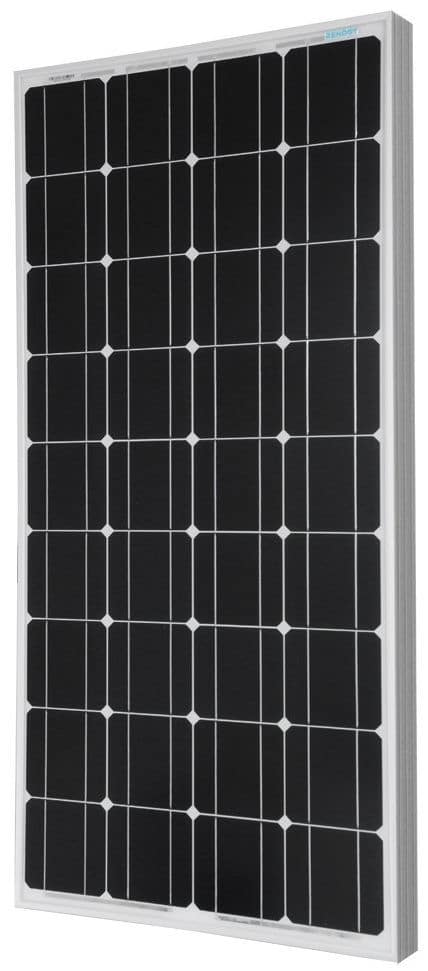
Connecting Solar Panels Together
How to Connect Solar Panels Together
![]() Connecting solar panels together is a simple and effective way of increasing your solar power capabilities. Going green is a great idea, and as the sun is our ultimate power source, it makes sense to utilize this energy to power our homes. As solar power becomes more accessible, more and more homeowners are buying photovoltaic solar panels.
Connecting solar panels together is a simple and effective way of increasing your solar power capabilities. Going green is a great idea, and as the sun is our ultimate power source, it makes sense to utilize this energy to power our homes. As solar power becomes more accessible, more and more homeowners are buying photovoltaic solar panels.
However, these photovoltaic solar panels can be very costly so buying them over time helps to spread the cost. But the problem then becomes how do we connect these extra solar panels together to increase the voltage and power output of what’s already there.
The trick here when connecting solar panels together is to choose a connection method that is going to give you the most energy efficient configuration for your particular requirements.
Connecting solar panels together can seem like a daunting task when you first start to look at how it should be done, but connecting multiple solar panels together is not that hard with a little thought. Wiring solar panels together in either parallel or series combinations to make larger arrays is an often overlooked, yet completely essential part of any well designed solar power system.
There are three basic but very different ways of connecting solar panels together and each connection method is designed for a specific purpose. For example, to produce more output voltage or to produce more current.
Solar photovoltaic panels can be electrically connected together in series to increase the voltage output, or they can be connected together in parallel to increase the output amperage. Solar pv panels can also be wired together in both series and parallel combinations to increase both the output voltage and current to produce a higher wattage array.
Whether you are connecting two or more solar panels, as long as you understand the basic principles of how connecting multiple solar panels together increases power and how each of these wiring methods works, you can easily decide on how to wire your own panels together. After all connecting solar panels together correctly can greatly improve the efficiency of your solar system.
Connecting Solar Panels Together in Series
The first method we will look at for connecting solar panels together is what’s known as “Series Wiring“. The electrical connection of solar panels in series increases the total system output voltage. Series connected solar panels are generally used when you have a grid connected inverter or charge controller that requires 24 volts or more. To series wire the panels together you connect the positive terminal to the negative terminal of each panel until you are left with a single positive and negative connection.
Solar panels in series add up or sum the voltages produced by each individual panel, giving the total output voltage of the array as shown.
Solar Panels in Series of Same Characteristics
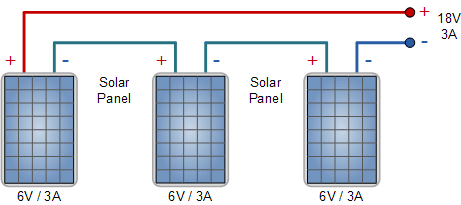
In this method ALL the solar panels are of the same type and power rating. The total voltage output becomes the sum of the voltage output of each panel. Using the same three 6 volt, 3.0 amp panels from above, we can see that when these pv panels are connected together in series, the array will produce an output voltage of 18 Volts (6 + 6 + 6) at 3.0 Amperes, giving 54 Watts (volts x amps) at full sun.
Now lets look at connecting solar panels in series with different nominal voltages but with identical current ratings.
Solar Panels in Series of Different Voltages
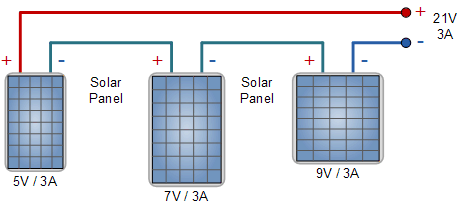
In this method all the solar panels are of different types and power rating but have a common current rating. When they are connected together in series, the array produces 21 volts at 3.0 amps, or 63 watts. Again the output amperage will remain the same as before at 3.0 amps but the voltage output jumps to 21 volts (5 + 7 + 9) .
Finally, lets look at connecting solar panels in series with completely different nominal voltages and different current ratings.
Solar Panels in Series of Different Currents
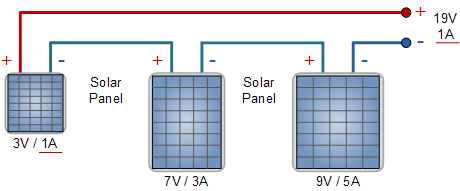
In this method all the solar panels are of different types and power rating. The individual panel voltages will add together as before, but this time the amperage will be limited to the value of the lowest panel in the series string, in this case 1 Ampere. Then the array will produce 19 Volts (3 + 7 + 9) at 1.0 Ampere only, or only 19 watts out of a possible 69 watts available reducing the arrays efficiency.
We can see that the solar panel rated at 9 volts, 5 amps, will only use one fifth or 20% of its maximum current potential reducing its efficiency and wasting money on the purchase of this solar panel. Connecting solar panels in series with different current ratings should only be used provisionally, as the solar panel with the lowest rated current determines the current output of the whole array.
Connecting Solar Panels Together in Parallel
The next method we will look at of connecting solar panels together is what’s known as “Parallel Wiring“. Connecting solar panels together in parallel is used to boost the total system current and is the reverse of the series connection. For parallel connected solar panels you connect all the positive terminals together (positive to positive) and all of the negative terminals together (negative to negative) until you are left with a single positive and negative connection to attach to your regulator and batteries.
When you connect solar panels together in parallel, the total voltage output remains the same as it would for a single panel, but the output current becomes the sum of the output of each panel as shown.
Solar Panels in Parallel of Same Characteristics
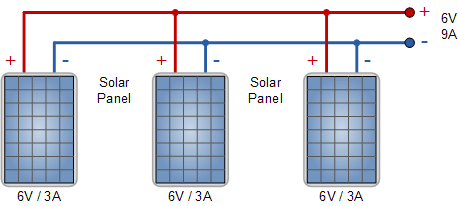
In this method ALL the solar panels are of the same type and power rating. Using the same three 6 Volt, 3.0 Amp panels as above, the total output of the panels, when connected together in parallel, the output voltage still remains at the same value of 6 volts, but the total amperage has now increased to 9.0 Amperes (3 + 3 + 3), producing 54 watts at full sun.
But what if our newly acquired solar panels are non-identical, how will this affect the other panels. We have seen that the currents add together, so no real problem there, just as long as the panel voltages are the same and the output voltage remains constant. Lets look at connecting solar panels in parallel with different nominal voltages and different current ratings.
Solar Panels in Parallel with Different Voltages and Currents
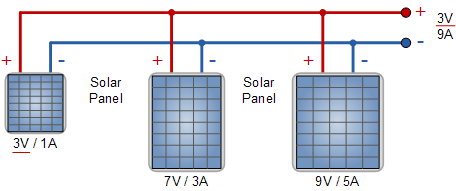
Here the parallel currents add up as before but the voltage adjusts to the lowest value, in this case 3 volts or some voltage value very close to 3 volts. Solar panels must have the same output voltage to be useful in parallel. If one panel has a higher voltage it will supply the load current to the degree that its output voltage drops to that of the lower voltage panel.
We can see that the solar panel rated at 9 volts, 5 amps, will only operate at a maximum voltage of 3 volts as its operation is being influenced by the smaller panel, reducing its efficiency and wasting money on the purchase of this higher power solar panel. Connecting solar panels in parallel with different voltage ratings is not recommended as the solar panel with the lowest rated voltage determines the voltage output of the whole array.
Then when connecting solar panels together in parallel it is important that they ALL have the same nominal voltage value, but it is not necessary that they have the same ampere value.
Connecting Solar Panels Together Summary
Connecting solar panels together to form bigger arrays is not all that complicated. How many series or parallel strings of panels you make up per array depends on what amount of voltage and current you are aiming for. If you are designing a 12 volt battery charging system than parallel wiring is perfect. If you are looking at a higher voltage grid connected system, than you’re probably going to want to go with a series or series-parallel combination depending on the number of solar panels you have.
But for a simple reference in regards to how to connect solar panels together in either parallel or series wiring configurations, just remember that parallel wiring = more amperes, and series wiring = more voltage, and with the right type and combination of solar panels you can power just about any electrical device you may have in your home.
For more information about Connecting Solar Panels Together in either series or parallel combinations, or to obtain more information about the different types of solar panels available, or to explore the advantages and disadvantages of using solar power in your home, then Click Here to order your copy from Amazon today and learn more about designing, wiring and installing off-grid photovoltaic solar electric systems in your home.





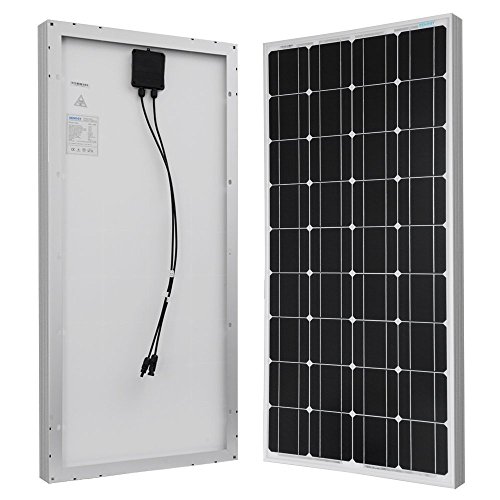





This is great, It shows the competency of the installer
i have a 300w solar panel,a 80w solar panel,a 200ah solar battery,a 30amp controller and 1000w inverter.how do i connect?
Use the 300W panel, and sell the 80W panel. They are not compatable.
This article has been very useful and on point thanks, I would like to have more tutorials on solar systems
hello am new to solar but a do it yourself person. i have 5 270w 24v panel with a 80a mppt charge controller recently buy 3 250w 36v panels. what is the best way to wire them to 1 charger controller
3 x 24V series panels in parallel with 2 x 36V series panels will give a DC voltage of 72 volts. This will give at “Full Sun” 18.2A, 1310 watts
I have 10 solar plates of 30 w and 1.4 A each and 10 plates 65 w and 1.54 A each. How to connect for best power to run 1.2 KV inverter and charge 12 volt tabular battery.
Avez vous déjà parlé de diode et leur efficacité/utilisation?
Please read our tutorial about Bypass Diodes
Hi
I am planning for 8 panels and another string(585W) in serie for Voc 440 V and 16 A and the wiring between the panels is 4 mm but i think to use 6mm to going to my fuses(20Amp…?)and from there te same 6mm cable to my CC( victron rs 450/100)is this wiring size okay afterwards I will use 35 mm cable and 125 Amp breakers
The size, or diameter, of cable used to wire a DC solar system basically depends on two things. No1, the amount of current it needs to carry and, No2, the length of the cable run.
No1. An electric cable has a certain amount of resistance measured in Ω x metres, and since the cable is part of the electrical circuit, it can be treated as a resistor. When an electric current flows through a cable, the cable heats up. Power is lost in the form of heat. These losses are called cable losses. The amount of cable losses can be calculated as: P = I2*R (Power = Current2 x Resistance).
So for a given fixed current, a thin cable which has a higher resistance per metre than a thicker cable of the same length will generate more losses and heat up for a given current magnitude. Copper conducts electricity very well and has a low resistance per metre which is why electric cables are made from copper. Thus a 6mm2 cable is better than a 4mm2 cable, since 6mm2 cable can handle more current and is generally good upto about 30 Amperes (DC rating) or so, for short cable runs.
No2. If a cables resistance is measured in Ω x meters, it follows then that a long cable run will have a higher resistance than a short cable run of the same thickness. Thus a V = I x R voltage drop will be created over the length of the cable. Remember there are two cables, positive (+) and negative (-), so the total voltage drop will be double.
Then for long cable runs, we need to keep the cable resistance down overall to prevent large voltage drops (power loss) over the cable length and stop the cable from heating up. Thus again, a larger diameter 6mm2 cable is better for long cable runs since an increased current will increase the voltage drop and the cable will heat up more for smaller sized cables.
I currently have 4 200 watt rich solar panels max power voltage is 37.6. im going to add two more of the same panels. the charge controller is an ampinvt 60 amp. connected to 2 200ah 12v lifepo4 batteries connected in series. max voltage the charge controller is 100v. how should i wire the 6 Panels. the 4 i have connected now is in series parallel
Clearly add the two extra panels as another parallel branch, as your charge controller can only work with two panels in series (2 x 37.6 = 75.2 volts). Then, 3 parallel branches of 2 panels, (2S3P)
Thank you for your reply, instead of ordering two more i ordered 4 (Amazon prime day) so i would add these in parallel. and that would add to the amps and not voltage, correct?
Series connections increases Voltage. Parallel connections increases Current
It’s very interesting
Thanks
I currently have 16 x 550W panels with 8 each connected in series to 2 x Growatt SPF 5000 Inverters. I wish to add more panels in order to maximise the output from the inverters. The specifications of the panels are Vmp 31.6V, Imp 17.4A, Voc 37.9 and Isc 18.52A. For the inverters, the Max. PV Array Open Circuit Voltage has 450Vdc and Max. PV Array Power is 6kW.
I am considering using 11 of the existing panels for Inverter A in series thereby having Max Voc of 425.24V @ 20degrees Centigrade, Max Voltage input of 347.6V and Max Current of 17.4A.
I intend to use remaining 5 existing panels for Inverter B and ADD 6 new 550W panels.The challenge is that I cannot get panels of the same specifications. Can I connect the current and new panels as 5 current panels in series, the 6 new in series, and have both in parallel? What will be the Max Voc, Max Voltage Input and Max Current Input? What are the other options of getting them connected?
I didn’t see a Series / Parallel configuration where the inner + and – are connected and the outer minuses (-) are connected and the other pluses (+) are connected. I did this with 4 panels on my RV. My lithium battery is dead. I’ve got to turn off the main connection on the main shore panel and maybe pull the connection to the shore fridge hooked to the 2000W Inverter. I don’t know if I’m getting any solar energy. My controller is dead. We will see.
We cover series / parallel combinations in our Parallel connected solar panels tutorial
l have 4 x300 watts panels and 3,5 kva invecter how do i connectt it because i try to connect sirie it dosnt show the panels on screen
It depends on the DC input characteristics of your inverter, but a series connection would be better, higher voltage, lower amps. If your inverter does not show your panel configuration, either its incorrectly wired, or your inverter is faulty. Check the DC input voltage to the inverter using a digital voltmeter and compare to the screen.
Hello sir I have a 12v 220a battery and a 1kva inverter and 2, 450 watt panels how do I connect the panels my charge controller is 80a 12v,24v,48v auto
Then again I have twelve 300 watts panels 5kva hybrid inverter and four 12v 200a battery I need to make it 48v system please how do i do the panel configurations
1. 450W pv panels are generally rated as 24V panels, then the two in parallel.
2. Depending on the maximum open-circuit DC input characteristics of your controller/inverter, for 48V operation, 2 in a series strings and 6 parallel branches (2S6P), or 3 in a series string and 4 parallel branches (3S4P)
hello i have 9x 235w panels giving 29.5v at 7.97 amps to a (2)100amp mppt controller on 24volt to 4 x 130 ah wet batteries wired series/parallel to a 2500w(5000wsurge) 24v invertor to run two caravans on mains connection which would be the best way to wire the panels ? 2 x 4 panels with one spare? in parallel or all nine in parallel and increase battery storage upto 8 x 130 ah wet batteries to two inverters? thanks for any advice you can give me
The configuration of your photovoltaic panels will depend on the maximum PV array paramenters of your controller with regards to system voltage and open circuit voltage (Voc), since a 235W, 60 cell panel can be as high as 40 volts. Then if you plan on connecting 4 in series, your Voc could reach 160 volts. As you have stated, you have 9 x 235W panels, then the maximum wattage your array can generated at FULL SUN is 2115W, no matter how you configure them. Again, higher voltage is better than higher current as it allows for smaller diameter cabling.
Hi Sir, I have 315w 24v 9 panels and 2kw 24v hybrid solar invertor with batteries; how i will connect these panels , plz share a diagram, i want to made a rooftop installation . Thanks in advance
My 5kva invater is not charging with 220volt
Hi good evening please I have 8 450 WATT of solar panels with 30 volt from each panels, now I connect 4, 4 in series which now give me 120 volt and 30 AMP and using an MPPT CHARGING CONTROLLER 120, AMP with Maximum PV input 195 volt, wire with 16 MM cable but I now discover that the wire from the charging controller to the head of the batteries is hot, please what cam be the caused of this?
16mm2 cable should be good for 30 amperes. Is your cable hot along the entire length of the cable, or just hot at one end near the battery joint. If the ends of the wire are hotter, that may be a sign of a bad connection at that end.
Heat is the result of I2R power loss along the whole length of a cable, and some “warm” wires in a DC solar setup is normal. Use a multi-meter to check the voltage drop between both ends of the cable. 3% difference or less is ok. Then check all connections and monitor over time.
If i use 4 panels of 550 watt with 3.5 kw inverter and 2 batteries of 12v then what appliances can i run with this setup?
Any you want upto the maximum rating of your inverter
Hi, I want to use this opportunity to say thank you for this information I really learn from it and I we like to know more sir
thanks for your advice , the best but sometimes confusing , so here I go … I’m wishing to connect 3 solar panels of 300 watts each in parallel in a 12 volt system where the Maximum Power Current IMP:17.24A
– Maximum Power Voltage VMP:17.4V
– Short Circuit Current ISC:18.27A is for each panel and I wish to run the the combined output to a 40 amp controller then via a 40 amp ciircuit breaker to 100 Ah battery . Q1 , what is the total wattage feeding to the controller ? Q2 , is it necessary to place an inline fuse on each panel + outlet before joing up to common + output to the controller … thanks …
Q1. 3 x 300W = 900W at Full Sun
Q2. Individually if you want for safety reasons, but not necessary. Blocking diodes would be a better option.
Dear Sir
we have 27 solar panel .of 100 w.Imp 5.71 A and Vmp 17.50 V , with inverter PV18-3024 VPM ,power rated 3000W ,Input Dc 24 VDC 130 A ,AC input 230 VAC 50 Hz ,13 A .DC output 27DC , can you please advise us what is the best way to do the connection ,we have 4 batteries of 175 Amp ,12 V ,each
Data given: “Input Dc 24 VDC 130 A” Then two panels in series and 13 parallel branches the same (2S13P). Leaves one spare panel.
Data given: “DC output 27DC” with 4 batteries, two in series (24V) and two parallel branches (2S2P).
Good morning sir..
Your reply will be very much appreciate sir
My question is.
I have 180watt 3 panel and 50amp charger control / 220ah tub battery… Am only using 150watt from 8am to 8pm and am having low battery by 5pm of the day. I connected all my panel in parallel. Please advise me on how to go about it for the battery to save me till 8pm
If your panels are rated at 180 watts each, and you state you have 3. Then that gives a total of 3 x 180 = 540 watts. This 540 watts is ONLY available during “full sun” conditions, about 4 to 5 hours per day. Assuming 4 hours gives: 4 x 540 = 2160 watt-hours per day max from your 3 pv panels to charge your 220Ah battery. Then 2160/220 = 9.8 hours (8am to 5:45pm) approx.
You consume 150W for 9 hours (8am to 5pm) which equals 1350 watt-hours per day.
To consume 150W for 12 hours (8am to 8pm) is about 1800 watt-hours per day. 1800 – 1350 = 450 watts-hours extra consumption per day.
Extra time is: 12 – 9 = 3 hours. 450/3 = 150 watts per hour. 150/180 = 0.8 or 1 whole panel extra. Then you need 4 pv panels in total.
4 panels x 180W x 4hrs = 2880 watt-hours per day. Therefore: 2880/220 = 13 hours (8am to 9:00pm) approx.
Clearly, system losses, configuration and efficiency are not considered here.
Hi
If connected two or more different photovoltaic panel do not required diode in serial?
If connect diode some pv do not product energy because the diode is polarity reverse.
How bypass that problem?
Thank you.
Hi guys, I have 4 x 200w panels (only 3 connected) but may be adding another 2 x 200w (all the same, some time in the future). i have an mppt dcdc charger 50a which can handle 660w. Will need to ad another mppt (60a) controller when the 3 other panels are installed. All of this feeding 2 x 200a life po4 batteries plus 500a shunt and a 2000w PSW inverter charger. How do you recommend to connect these items. They are going into my caravan so a 12v dc system.
i see having dcdc/ mppt output connected to battery bank. inverter charger (240v) connected to battery bank. shunt connected to battery bank. panel configuration not sure of ??
Please sir if I have 5 solar panel of 280watt and 42.25volt and 6.63A each and one 200watt panel 36.90volt, 5.42A to power 24volt system… How should I connect my panel
Pls respond with my Gmail
What are the DC input characteristics of your charge controller
How to connect 50w,20w, and 10w panels to charge two 12v batteries.in parallel
In parallel, and the 10W panel will dominate
Hi sir my name is Suleiman I have a question about panels connection I have a 3 panels 180watt and then 1 200v battery and 12v inverter how to connect panels sir
A 200v battery is a very big battery
How do I wire 5 panels of 300w/10.2amps/32volts to obtain a 24volt system?
Again, clearly it will depend on the DC input characteristics of your connected 24V charge controller. One series string of 2, 3, 4, or 5 panels, or two parallel branches of 2 panels per branch (2S2P).
This so educating
I have 4 solar panel equivalent 840 2 PCs 600w and the other 2 is 240w is it possible to work this solars together
If I want to connect 330w×9pannel to produce 48v system , how will I go about it, and the panel are 12
Clearly, 48 divide by 12 equals 4 panels per series string. 2 series strings in parallel equals 8 panels, plus one unused spare.
My name is Nelson. The Question i have is this: If 14 solar (PV)panels of 200 watts each, and 18.9V each and, the inverter provided is 3.5KVA, How will the Panels be connected; to enable the 3.5kva inverter produce a 240volts output to the load? Your reply to my email will be highly appreciated, thanks.
If you have 14, 200 watt panels, then the maximum power you can generate at full sun would be 2800 watts, or 2.8kva. Clearly your panel configuration will depend on the DC input specifications of your inveter.
You could connect your 14 panels together in one series string to give: 14 x 18.9 = 265 volts, or 7 in series and two parallel branches (7S2P) giving 7 x 18.9 = 132 volts.
if I have 5 panels each one of them is 550 watt, 49 volt and 13 ampere, connecting on series to produce 2750 watt and 245 volt or some close to that, my hybrid inverter mppt is 120-450 volt and its nominal operating voltage at solar charger mode is 360 VDC knowing that the inverter I have works even without batteries but I will connect the batteries for stability because I think the panels voltage are not enough, the inverter is 48 volt and its rated power is 5000 watt, I will connect 4 batteries as I told you. will the inverter work knowing that my loads are less than 2000 watt in daytime with the sun? the next question, one of my panels has fallen from the roof and its production became 44 volt and 4.5 ampere, can I use it with the 4 panels to benefit from the voltage, I mean is there any way, diode or somthing like that from the market that can allow only the voltage without letting the 4.5 amperes of the broken panel to flow?
1. If your 2000 watts is within the specification of the inverter then yes. 5000 watts will be its maximum power rating.
2. Photovoltaic (PV) panels generate voltage when exposed to sunlight. This voltage is generated whether the panel is connected to a load or not (Vmp versus Voc). Electric current ONLY flows around a closed circuit. Thus if the panel is open-circuited, no current flows. If the panel is connected to a load, then a closed path is created for current to flow. The magnitude of the current will depend on the impedance of the connected load. Then no, if you connect the damaged panel to the rest of your system, electric current will flow when there is sufficient sunlight.
I have 900watts DC brushless self-priming pump on 72volt how many solar panels are needed to run it.
I have read on the web that there should be a diode (blocking reverse flow of current) inserted between PV panels arranged in parallel. I have two small 12v panels (50W + 30W) and I want to chain them in parallel to get 80W @ 12v. Do I have to put a diode somewhere in the wiring between the panels and the battery? Or just between the two panels?
Please see our tutorial about the Photovoltaic Array
Hi I have 4.2 kw controller(ups) and 8 solar panel of 545 watt each , each panel 48 volt , each panel current is 10 amp at its peak Now , i have a question How can i arrange these panels to get max output? If i put 6 panel in series and 2 panel in parallel then connect these together , what is my output ? I require max output Kindly guide me
hello some advice please
i have 4 x 235w panels voc 37v rated 29.5v to power 4 x 130 ah wet battery bank wired series and parallel via a 100amp mppt controller and 24v 6000w invertor would i be better off wiring the panels in parallel or series
thanks for your help and advice
Please I have 2 Panels 270Watts each, connected to a charge controller that charges a 12Volts 200AH battery. I just bought another 2 Panels 300Watts each to be connected together with the existing system. I am thinking if I pair 270W panel with 300 W panel in series before connecting them all in parallel will reduce the loss?
We expect that there would be very little difference in the I-V characteristics between your 270W and 300W panels, as there is such a small difference in wattage, 270W compared to 300W. Thus the Vmp and Voc voltages would be very similar. But the Imp and Isc values would be more different. Then 2 x 270W in one series string, and 2 x 300W in a second series string, with both strings in parallel. That way the voltages would balance out but you would still get different branch currents relating to the wattages.
Currently, I have a 24v system with 24v panels connected in parallel. I want to step down to 12v system without changing the 24v panels, I just want to buy one 12v panel and connect in parallel.
1) What is the effect of 12v panel besides reducing the voltage output of other 24v panels to 12v?
2) Would the 24v panels retain their qualities in case I return to the 24v system after a few years?
1) It does not work like that. Your output would be around 18 volts and your 24 volt panels would be feeding current directly into the smaller 12 volt panel due to such a large mismatch.
2) Probably not, as they would deteriorate over time anyway, and would see your 12 volt panel as the load
Ok.
Can I step the 24v panels down to 12v using my PMT 12v/24v Charge control?
I want to scale down to 12v without throwing my active panels into the bin.
Yes, if the configuration of your charge controller allows it
Hi
If I got 2 x 200w Omega OSP201 Panels connected in series
VOC – 22.2; SCC(A) – 8,6; VMP(v) – 18; Max VMP – 8,11
Connected to 2×180 amp/h batt in Paralel with 2000w Pure Sine inverter and 20 Amp Solar control charger.
Is it the correct way?
Thank you, I’m following
We guess so, if that is how they have been installed
I have 24 x 230 W 37 volt 7.8 Amp panels. In order to fit these panels into my all-in-one EGR 120/240 6000 inverter I have to have a 500 volt max. I believe the only way to meet the 500VOC max requirement, I would need to wire 12 panels in Series and 12 panels in Parallel giving me
12 x 7.8 = 93.6 amps and 37 volts in Parallel + 12 x 37 Volts = 444 Volts and 7.8 Amps in Series Can I combine the 2 Arrays?
12 panels in parallel with 12 panels in series, No.
12 panels in one series string equals 444 volts, and 2 series strings in parallel (12S2P) equals 15.6 (7.8 + 7.8) amperes.
If I connect two 18v panels in series creating 36v output, then connect this array in parallel with two other 36v panels, if one of the 18v series panels is in shade, how will it affect the total output.
The output will be derated as a result of shading as explained in our tutorial about Bypass Diodes
Many thanks appreciate your help.
The connection solar Panels was useful to me, so I am saying thank you, and hope to learn more from you